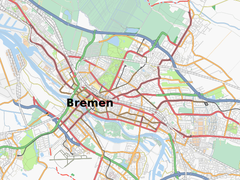Places
- For the wiki template, see Template:Place.

|
| Description |
| The place tag is used on a single node to mark the centre of a named settlement as well as on the whole area to mark its extent. |
| Tags |
Places include populated settlements, including city, town, village, suburbs, neighbourhoods and hamlets etc and also unoccupied identifiable places ranging from very large (continents and oceans) down to very small features are identified using the place=*.
How to map
A place can be both a single node tagged with place=* roughly in the perceived centre of the place, for example the town or village square to the central in terms of facilities and/or transport routes or next any appropriate central monument. A place can also be defined by using an existing area.
Proposals
Questions
What makes a road belong to a city?
Ideally, an administrative border (boundary=administrative) should surround the place. This makes it easy to automatically determine "where" every place is. Note though that not all places (even hamlets, villages etc) are administrative units in their own right.
The Karlsruhe Schema lets you define which postcode and postcode-area-name each way or house has.
For many areas, the information on where exactly the administrative border is, is not freely available to use for OSM. A common fall-back method is then to use the nearest place=* nodes.